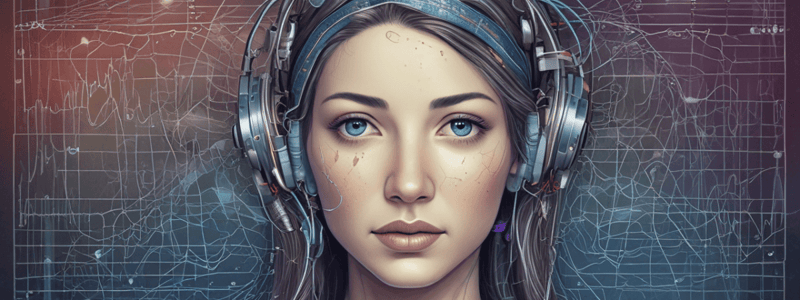Podcast
Questions and Answers
What is the most common cause of lesions that lead to LPDs?
What is the most common cause of lesions that lead to LPDs?
- Ischemic strokes (correct)
- Brain tumors
- Abscesses
- Intracranial hemorrhages
What is the prognosis of LPDs dependent on?
What is the prognosis of LPDs dependent on?
- The duration of the EEG pattern
- The age of the patient
- The underlying etiology (correct)
- The frequency of seizures
What is the characteristic of BIPDs that distinguishes them from LPDs?
What is the characteristic of BIPDs that distinguishes them from LPDs?
- Bilateral occurrence (correct)
- Unilateral occurrence
- Rhythmic buildup
- Focal occurrence
What is the mortality rate associated with BIPDs?
What is the mortality rate associated with BIPDs?
What is the condition most recently associated with GPDs?
What is the condition most recently associated with GPDs?
What is the characteristic of LPDs+ that distinguishes them from LPDs?
What is the characteristic of LPDs+ that distinguishes them from LPDs?
What is the stage of convulsive status epilepticus in which the EEG may appear as GPDs?
What is the stage of convulsive status epilepticus in which the EEG may appear as GPDs?
What percentage of patients experienced a seizure during the cEEG monitoring in a retrospective study?
What percentage of patients experienced a seizure during the cEEG monitoring in a retrospective study?
How often should critical care continuous EEG be reviewed and interpreted by neurophysiologist/intensivist/neurologist?
How often should critical care continuous EEG be reviewed and interpreted by neurophysiologist/intensivist/neurologist?
What type of seizures were experienced by all patients in the retrospective study?
What type of seizures were experienced by all patients in the retrospective study?
What is the association between generalized periodic discharges and neurological outcomes?
What is the association between generalized periodic discharges and neurological outcomes?
What is the interval at which periodic discharges typically occur?
What is the interval at which periodic discharges typically occur?
What type of periodic discharges are seen unilaterally and occur periodically or pseudo-periodically?
What type of periodic discharges are seen unilaterally and occur periodically or pseudo-periodically?
What should be done if frequent nonconvulsive seizures or nonconvulsive status epilepticus are identified during cEEG monitoring?
What should be done if frequent nonconvulsive seizures or nonconvulsive status epilepticus are identified during cEEG monitoring?
What is the recommended frequency for reviewing cEEG for patients at risk for acute ischemic stroke?
What is the recommended frequency for reviewing cEEG for patients at risk for acute ischemic stroke?
What is the predictive value of specific pathologic or physiologic EEG patterns in patients with postanoxic encephalopathy following cardiac arrest?
What is the predictive value of specific pathologic or physiologic EEG patterns in patients with postanoxic encephalopathy following cardiac arrest?
What is the significance of deep coma in the first hours after cardiac arrest?
What is the significance of deep coma in the first hours after cardiac arrest?
What is the significance of lack of clinical improvement after several days in patients with unconsciousness after cardiac arrest?
What is the significance of lack of clinical improvement after several days in patients with unconsciousness after cardiac arrest?
What is the significance of recovery towards continuous, physiologic EEG rhythms within 12 hours?
What is the significance of recovery towards continuous, physiologic EEG rhythms within 12 hours?
What is the significance of absence of relevant improvement within 24 hours, with persistent isoelectric, low voltage or burst suppression with identical burst patterns?
What is the significance of absence of relevant improvement within 24 hours, with persistent isoelectric, low voltage or burst suppression with identical burst patterns?
What is the significance of EEG monitoring in patients with aneurysmal SAH?
What is the significance of EEG monitoring in patients with aneurysmal SAH?
What is the EEG signal in relation to brain function?
What is the EEG signal in relation to brain function?
What is the primary benefit of using EEG monitoring in ICU patients?
What is the primary benefit of using EEG monitoring in ICU patients?
What is the purpose of trending quantified EEG features in ICU patients?
What is the purpose of trending quantified EEG features in ICU patients?
What is the primary limitation of quantified EEG summaries in ICU patients?
What is the primary limitation of quantified EEG summaries in ICU patients?
What is the importance of reviewing the actual raw EEG data in ICU patients?
What is the importance of reviewing the actual raw EEG data in ICU patients?
What is the significance of frontally predominant brief 2/second generalized rhythmic delta activity in ICU EEG recordings?
What is the significance of frontally predominant brief 2/second generalized rhythmic delta activity in ICU EEG recordings?
What is the purpose of identifying pseudo-periodic LPDs in ICU EEG recordings?
What is the purpose of identifying pseudo-periodic LPDs in ICU EEG recordings?
What is the significance of TWs in ICU EEG recordings?
What is the significance of TWs in ICU EEG recordings?
Why is it necessary to document all equipment attached to the patient during EEG monitoring?
Why is it necessary to document all equipment attached to the patient during EEG monitoring?
What is the primary source of neurologic co-morbidity after Subarachnoid Hemorrhage (SAH)?
What is the primary source of neurologic co-morbidity after Subarachnoid Hemorrhage (SAH)?
What is the median incidence of vasospasm after SAH?
What is the median incidence of vasospasm after SAH?
What can be used to detect vasospasm and guide therapy methods?
What can be used to detect vasospasm and guide therapy methods?
What is the outcome of patients with SAH who have persistently poor EEG variability and reactivity?
What is the outcome of patients with SAH who have persistently poor EEG variability and reactivity?
What is a marker for altered cerebral function accompanying vasospasm in SAH patients?
What is a marker for altered cerebral function accompanying vasospasm in SAH patients?
When should EEG monitoring be continued for patients with SAH?
When should EEG monitoring be continued for patients with SAH?
What is the optimal duration of monitoring for ischemia in patients with crescendo transient ischemic attack?
What is the optimal duration of monitoring for ischemia in patients with crescendo transient ischemic attack?
What is the suggested method to identify ischemia in at-risk patients?
What is the suggested method to identify ischemia in at-risk patients?
Flashcards
Subclinical Seizures in TBI
Subclinical Seizures in TBI
Seizures in Traumatic Brain Injury (TBI) patients that are not noticeable by outward symptoms.
Non-Convulsive Status Epilepticus (NCSE)
Non-Convulsive Status Epilepticus (NCSE)
A serious neurological condition characterized by prolonged seizures that aren't outwardly convulsive.
cEEG Monitoring
cEEG Monitoring
Continuous Electroencephalography (EEG) monitoring in critical care settings.
Periodic Discharges (PDs)
Periodic Discharges (PDs)
Signup and view all the flashcards
Generalized PDs
Generalized PDs
Signup and view all the flashcards
Lateralized PDs
Lateralized PDs
Signup and view all the flashcards
Bilateral Independent PDs
Bilateral Independent PDs
Signup and view all the flashcards
Vasospasm
Vasospasm
Signup and view all the flashcards
Delayed Cerebral Ischemia (DCI)
Delayed Cerebral Ischemia (DCI)
Signup and view all the flashcards
Post-Anoxic Encephalopathy
Post-Anoxic Encephalopathy
Signup and view all the flashcards
ICU-EEG Monitoring
ICU-EEG Monitoring
Signup and view all the flashcards
Quantified EEG Analysis
Quantified EEG Analysis
Signup and view all the flashcards
Alpha Activity
Alpha Activity
Signup and view all the flashcards
EEG Artifact
EEG Artifact
Signup and view all the flashcards
Relative Alpha Variability
Relative Alpha Variability
Signup and view all the flashcards
Study Notes
Seizures in TBI Patients
- 18% of TBI patients experience seizures during cEEG monitoring, all of which are subclinical seizures.
- 8% of TBI patients develop non-convulsive status epilepticus (NCSE).
Critical Care Continuous EEG Monitoring
- cEEG monitoring should be reviewed as often as logistically and technically feasible.
- Interpretation should be done by a neurophysiologist/intensivist/neurologist at least twice daily.
- More frequent interpretation should be provided if frequent NCS or NCSE are identified until seizures are controlled.
- If clinical events are recorded, cEEG should be interpreted as soon as possible after the event to determine whether the events are ictal or non-ictal.
Periodic Discharges and Patterns on the Ictal-Interictal Continuum
- Periodic discharges (PDs) are associated with poor neurological outcomes and are strongly associated with NCS and NCSE.
- Generalized PDs are associated with NCS and NCSE.
- Lateralized PDs are associated with structural or focal lesions, such as ischemic strokes, and may co-occur with seizures.
- Bilateral independent PDs arise from more morbid conditions and have a worse prognosis.
- Rhythmic buildup of LPDs+ is thought to precede seizures.
ICU-EEG Monitoring
- cEEG monitoring is suggested as an adjunct method to identify ischemia in at-risk patients.
- EEG monitoring should be continued until the window for vasospasm has passed (day 14) or the patient is considered no longer at risk for vasospasm.
- The optimal duration of monitoring for ischemia in other patient groups has not been established and should be individualized for the specific clinical situation.
Cerebral Ischemia, Subarachnoid Hemorrhage (SAH), and Delayed Cerebral Ischemia (DCI)
- Vasospasm is a primary source of neurologic co-morbidity after SAH, with an incidence of 8-68% with a median of 38%.
- cEEG ICU monitoring can track cerebral activity continuously and identify changes suggestive of impending ischemia before infarction occurs.
- Decreased relative alpha variability is a marker for altered cerebral function accompanying vasospasm.
Outcome Prediction in Post-Anoxic Encephalopathy
- Specific pathologic or physiologic EEG patterns can accurately predict either a poor or good outcome of patients with post-anoxic encephalopathy following cardiac arrest.
- Deep coma in the first hours after cardiac arrest does not necessarily preclude full functional recovery, and improvement of brain function is possible even if the EEG is initially isoelectric.
- Lack of clinical improvement after several days is associated with a poor prognosis if the patient is off sedation.
Quantified EEG Analysis
- Automated extraction and trending of quantified EEG features can assist staff in monitoring EEG.
- Features commonly chosen for monitoring include percentage of alpha activity, total power or amplitude, ratio between alpha and delta activity, and spectral edge or mean frequency.
- Caution: Quantified summaries of EEG activity are subject to technical artifacts, including head movement, muscle activity, and electrocardiogram (ECG).
Studying That Suits You
Use AI to generate personalized quizzes and flashcards to suit your learning preferences.
Related Documents
Description
This quiz covers the occurrence of seizures in Traumatic Brain Injury (TBI) patients, particularly during continuous EEG monitoring, and the importance of frequent interpretation by neurophysiologists. It also touches on the development of non-convulsive status epilepticus.





